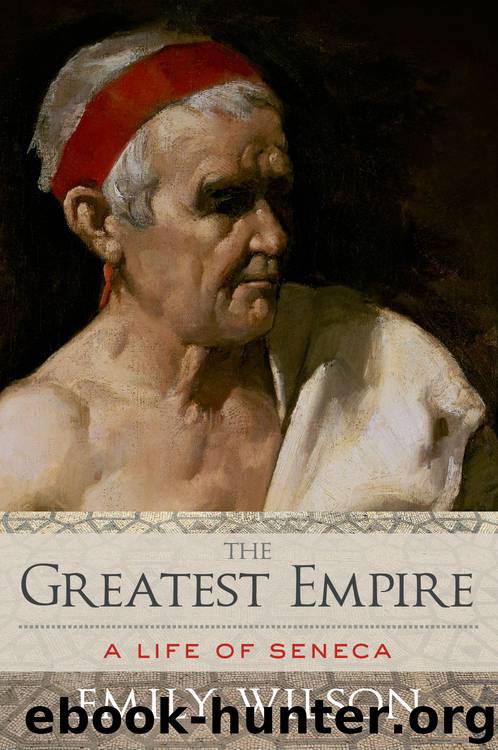The Greatest Empire by Emily Wilson

Author:Emily Wilson
Language: eng
Format: epub
ISBN: 9780199926640
Publisher: Oxford University Press
Published: 2014-08-25T16:00:00+00:00
SENECA’S WEALTH
Poison is drunk from gold. 24
We turn now to one of the most fraught questions about Seneca’s life story: his vast accumulation of wealth under Nero. 25 For our purposes, there are three central questions. First, how rich was he? Second, how exactly did he get his money? And third, how can we reconcile his accumulation of wealth and property with the overwhelmingly negative depiction of riches in his writings? The first is relatively easy to answer; the second is harder; the third is by far the most difficult.
It is clear that Seneca was extremely rich. Cassius Dio tells us that under Nero, he accumulated over three hundred million sestertii, a very large sum, as well as a great deal of property, including several houses in Rome and elsewhere, and apparently large areas of land in the prime real estate area of central Rome as well as in other parts of Italy. He may well also have owned land in Egypt (Epistle 77), an important source of revenue, since Egypt was the primary grain supplier to the Empire. It is impossible to translate Roman money with any accuracy into modern currency, since the relative values of different types of object, and the value of labor, was radically different: property values were proportionately less, and, as in any preindustrialized economy, manufactured goods cost more. The ubiquity of slave labor also made the service economy very different. But we can get some idea of the scale of Seneca’s wealth by knowing that a single sestertius could buy two loaves of bread or a jug of wine, and that a legionary in the Roman army, in Seneca’s lifetime, earned 900 sestertii per annum. By today’s standards, then, Seneca was at least a multimillionaire.
Roman society in this period had an enormous wealth and power gap: the elite class was, in general, vastly richer than the mass of the general population. It has been suggested that there was not really anything equivalent to a middle class in Rome in this period; there was nothing in-between the super-rich and the working classes or peasants. 26 More recent studies suggest that there were middle-income Romans, but those constituted no more than ten percent of the population: the vast majority of people in the Empire lived at subsistence level or close to it, while the top one and a half percent controlled about a fifth of the total GDP (a proportion that is actually lower than in the contemporary United States but one that still represents a vast socioeconomic gap between rich and poor). 27 But Seneca’s wealth went beyond the norms even for the elite. By the latest estimates, the average yearly income for a man in the senatorial class was around three hundred thousand sestertii, and for one in the equestrian class it was less than a tenth of that figure. In this context, Seneca’s wealth was far above the average even in his disproportionately rich social class. Only a tiny handful of people in this period would have had anywhere near this much money and property.
Download
This site does not store any files on its server. We only index and link to content provided by other sites. Please contact the content providers to delete copyright contents if any and email us, we'll remove relevant links or contents immediately.
| Ancient & Classical | Arthurian Romance |
| Beat Generation | Feminist |
| Gothic & Romantic | LGBT |
| Medieval | Modern |
| Modernism | Postmodernism |
| Renaissance | Shakespeare |
| Surrealism | Victorian |
4 3 2 1: A Novel by Paul Auster(11046)
The handmaid's tale by Margaret Atwood(6852)
Giovanni's Room by James Baldwin(5877)
Big Magic: Creative Living Beyond Fear by Elizabeth Gilbert(4723)
Asking the Right Questions: A Guide to Critical Thinking by M. Neil Browne & Stuart M. Keeley(4574)
On Writing A Memoir of the Craft by Stephen King(4213)
Ego Is the Enemy by Ryan Holiday(3991)
Ken Follett - World without end by Ken Follett(3972)
The Body: A Guide for Occupants by Bill Bryson(3798)
Bluets by Maggie Nelson(3709)
Adulting by Kelly Williams Brown(3668)
Guilty Pleasures by Laurell K Hamilton(3586)
Eat That Frog! by Brian Tracy(3513)
White Noise - A Novel by Don DeLillo(3434)
The Poetry of Pablo Neruda by Pablo Neruda(3366)
Alive: The Story of the Andes Survivors by Piers Paul Read(3310)
The Bookshop by Penelope Fitzgerald(3225)
The Book of Joy by Dalai Lama(3217)
Fingerprints of the Gods by Graham Hancock(3211)
